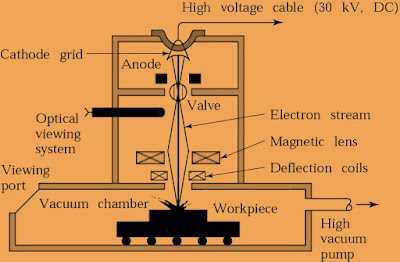Electron beam machining is processed by a high-velocity focused stream of electrons which heats, melts and vaporizes the work material at the point of bombardment thus metal will be removed.
The production of free electrons is obtained from thermo-electronic cathodes wherein metal are heated to the temperature at which the electrons have sufficient speed for escape and make the space around the cathode. Thus the electrons accelerate and are carried by an electric field and by controlled magnetic fields are using for focusing and concentration of that electric field. The kinetic energy of a beam of free electrons is transformed into heat energy thus the interaction of the electrons with the workpiece material. Therefore EBM is also called thermo-electric process.
Operation principle of electron beam machining :
A beam of electrons is emitted from the electron gun which is basically a triode consisting of
A gun is supplied with electric current from a high voltage D.C source. The flow of electrons is controlled by the negative bias applied to the grid cup. The electrons passing through the anode are accelerated to two-third of the velocity of light by applying 50 to 150 kV at the anode and this speed id maintained till they strike the workpiece.
A magnetic deflection coil is used to make the electron beam circular and its a cross-sectional diameter is 0.01 to 0.02 mm and deflect it anywhere.
A microscope with a magnification of 40 on the workpiece enables the operator to accurately locate the beam impact and observe the machining operation.
As the beam impacts on the workpiece surface the kinetic energy of high-velocity electrons is converted into the thermal energy and it vaporized the material at the spot of its impact.
The application of the above process is also found in electron-beam drilling in which an organic or synthetic backing material is sandwiched on the other side of the component.
Accuracy :
Tolerance is about 10% of slot width or hole diameter.
Taper about 4 degrees included angle
Depth to diameter ratio can reach 20:1 with multiple pulses.
Heat affected zone of up to 0.03 mm deep has been observed.
The production of free electrons is obtained from thermo-electronic cathodes wherein metal are heated to the temperature at which the electrons have sufficient speed for escape and make the space around the cathode. Thus the electrons accelerate and are carried by an electric field and by controlled magnetic fields are using for focusing and concentration of that electric field. The kinetic energy of a beam of free electrons is transformed into heat energy thus the interaction of the electrons with the workpiece material. Therefore EBM is also called thermo-electric process.
Operation principle of electron beam machining :
A beam of electrons is emitted from the electron gun which is basically a triode consisting of
- A cathode which is a hot tungsten filament ( 2500 degree C ) emitting high negative potential electrons.
- A grid cup, negatively based with respect to the filament.
- An anode which is heats at ground potential, and through which the high-velocity electrons pass.
A gun is supplied with electric current from a high voltage D.C source. The flow of electrons is controlled by the negative bias applied to the grid cup. The electrons passing through the anode are accelerated to two-third of the velocity of light by applying 50 to 150 kV at the anode and this speed id maintained till they strike the workpiece.
A magnetic deflection coil is used to make the electron beam circular and its a cross-sectional diameter is 0.01 to 0.02 mm and deflect it anywhere.
A microscope with a magnification of 40 on the workpiece enables the operator to accurately locate the beam impact and observe the machining operation.
As the beam impacts on the workpiece surface the kinetic energy of high-velocity electrons is converted into the thermal energy and it vaporized the material at the spot of its impact.
The application of the above process is also found in electron-beam drilling in which an organic or synthetic backing material is sandwiched on the other side of the component.
Accuracy :
Tolerance is about 10% of slot width or hole diameter.
Taper about 4 degrees included angle
Depth to diameter ratio can reach 20:1 with multiple pulses.
Heat affected zone of up to 0.03 mm deep has been observed.
